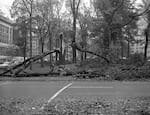The most destructive windstorm in the Northwest’s recorded history happened 60 years ago. The Columbus Day Storm, sometimes called “the Big Blow,” is practically Northwest lore. It’s one of those once-in-a-lifetime events that people still talk about, even if they didn’t experience it firsthand.
On Friday, October 12, 1962 — Columbus Day — a massive storm hit the coast of Northern California with the force of a Category 3 hurricane.

Bridge damaged in Columbus Day Storm.
Oregon State University Library and Special Collections and Archives
The Oregon Encyclopedia entry on the event says, “It may have been the most powerful extratropical cyclone ever to hit the western United States.”
Originally named Typhoon Freda, the storm raged up the Pacific Northwest, toppling tens of thousands of powerlines, flattening whole swaths of forests, and causing destruction all the way into Canada.
“— Oregon Encyclopedia. Jeff LaLande, Rogue River-Siskiyou National Forest historianOregon experienced the full brunt of the typhoon and suffered more damage than any other state.”
At Cape Blanco, in Southern Oregon, wind gusts were estimated at over 170 miles per hour. In Portland, winds on the Morrison Bridge hit 116 miles per hour.
Falling trees blocked roads and damaged thousands of homes. While downed powerlines created a dangerous mess for utility workers. Portland General Electric reported that 98 percent of its users lost power. The utility took two weeks to restore power to all of its customers, despite calling in crews from as far away as Montana.
The storm left at least 50 people dead and caused an estimated $200 million in damages in the U.S. — more than $3 billion in today’s dollars.
According to Oregon State University reports, the storm damaged as many trees as the combined annual tree harvest of both Oregon and Washington.

Columbus Day Storm damage at the South Park Blocks in Portland.
City of Portland Archives and Records Center


